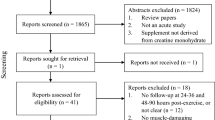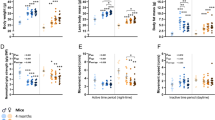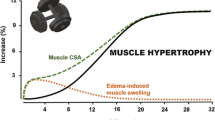Abstract
An acute bout of exercise can exacerbate pain, hindering participation in regular exercise and daily activities. The mechanisms underlying pain in response to acute exercise are poorly understood. We hypothesized that proton accumulation during muscle fatigue activates acid-sensing ion channel 3 (ASIC3) on muscle nociceptors to produce hyperalgesia. We investigated the role of ASIC3 using genetic and pharmacological approaches in a model of fatigue-enhanced hyperalgesia. This model uses two injections of pH 5.0 saline into muscle in combination with an electrically induced fatigue of the same muscle just prior to the second injection of acid to induce mechanical hyperalgesia. We show a significant decrease in muscle force and decrease in muscle pH after 6 min of electrical stimulation. Genetic deletion of ASIC3 using knockout mice and pharmacological blockade of ASIC3 with APETx2 in muscle prevents the fatigue-enhanced hyperalgesia. However, ASIC3−/− mice and APETx2 have no effect on the fatigue response. Genetic deletion of ASIC3 in primary afferents innervating muscle using an HSV-1 expressing microRNA (miRNA) to ASIC3 surprisingly had no effect on the development of the hyperalgesia. Muscle fatigue increased the number of macrophages in muscle, and removal of macrophages from muscle with clodronate liposomes prevented the development of fatigue-enhanced hyperalgesia. Thus, these data suggest that fatigue reduces pH in muscle that subsequently activates ASIC3 on macrophages to enhance hyperalgesia to muscle insult.





Similar content being viewed by others
References
Macedo LG, Bostick GP, Maher CG (2013) Exercise for prevention of recurrences of nonspecific low back pain. Phys Ther 93:1587–1591. doi:10.2522/ptj.20120464
Clauw DJ (2014) Fibromyalgia: a clinical review. In: JAMA. pp 1547–1555
Kosek E, Kosek E, Ekholm J et al (1996) Modulation of pressure pain thresholds during and following isometric contraction in patients with fibromyalgia and in healthy controls. Pain 64:415–423
Vlaeyen JWS, Linton SJ (2000) Fear-avoidance and its consequences in chronic musculoskeletal pain: a state of the art. Pain 85:317–332. doi:10.1016/S0304-3959(99)00242-0
Staud R (2007) Treatment of fibromyalgia and its symptoms. Expert Opin Pharmacother 8:1629–1642. doi:10.1517/14656566.8.11.1629
Light AR, Light AR, White AT et al (2009) Moderate exercise increases expression for sensory, adrenergic, and immune genes in chronic fatigue syndrome patients but not in normal subjects. J Pain 10:1099–1112. doi:10.1016/j.jpain.2009.06.003
Lin C-WC, Haas M, Maher CG et al (2011) Cost-effectiveness of guideline-endorsed treatments for low back pain: a systematic review. Eur Spine J 20:1024–1038. doi:10.1007/s00586-010-1676-3
McLoughlin MJ, Stegner AJ, Cook DB (2011) The relationship between physical activity and brain responses to pain in fibromyalgia. J Pain 12:640–651. doi:10.1016/j.jpain.2010.12.004
Staud R, Robinson ME, Price DD (2005) Isometric exercise has opposite effects on central pain mechanisms in fibromyalgia patients compared to normal controls. Pain 118:176–184. doi:10.1016/j.pain.2005.08.007
Ge H-Y, Ge H-Y, Arendt-Nielsen L, Arendt-Nielsen L (2011) Latent myofascial trigger points. Curr Pain Headache Rep. doi:10.1007/s11916-011-0210-6
Yokoyama T, Yokoyama T, Lisi TL et al (2007) Muscle fatigue increases the probability of developing hyperalgesia in mice. J Pain 8:692–699. doi:10.1016/j.jpain.2007.05.008
Sluka KA, Sluka KA, Rasmussen LA, Rasmussen LA (2010) Fatiguing exercise enhances hyperalgesia to muscle inflammation. Pain 148:188–197. doi:10.1016/j.pain.2009.07.001
Gregory NS, Gibson-Corley K, Frey-Law L, Sluka KA (2013) Fatigue-enhanced hyperalgesia in response to muscle insult: induction and development occur in a sex-dependent manner. Pain 154:2668–2676. doi:10.1016/j.pain.2013.07.047
Da Silva LF, Da Silva LF, DeSantana JM et al (2010) Activation of NMDA receptors in the brainstem, rostral ventromedial medulla, and nucleus reticularis gigantocellularis mediates mechanical hyperalgesia produced by repeated intramuscular injections of acidic saline in rats. J Pain 11:378–387. doi:10.1016/j.jpain.2009.08.006
Sluka KA, Sluka KA, Danielson J et al (2012) Exercise-induced pain requires NMDA receptor activation in the medullary raphe nuclei. Med Sci Sports Exerc 44:420–427. doi:10.1249/MSS.0b013e31822f490e
Steen K, Steen K, Issbemer U et al (2003) Pain due to experimental acidosis in human skin: evidence for non-adapting nociceptor excitation. Neurosci Lett 1–4
Frey Law LA, Frey Law LA, Sluka KA et al (2008) Acidic buffer induced muscle pain evokes referred pain and mechanical hyperalgesia in humans. Pain 140:254–264. doi:10.1016/j.pain.2008.08.014
Sluka KA, Sluka KA, Kalra A et al (2001) Unilateral intramuscular injections of acidic saline produce a bilateral, long-lasting hyperalgesia. Muscle Nerve 24:37–46
Immke DC, McCleskey EW (2001) Lactate enhances the acid-sensing Na+ channel on ischemia-sensing neurons. Nat Neurosci 4:869–870. doi:10.1038/nn0901-869
Light AR, Light AR, Hughen RW et al (2008) Dorsal root ganglion neurons innervating skeletal muscle respond to physiological combinations of protons, ATP, and lactate mediated by ASIC, P2X, and TRPV1. J Neurophysiol 100:1184–1201. doi:10.1152/jn.01344.2007
Sahlin K, Harris RC, Nylind B, Hultman E (1976) Lactate content and pH in muscle obtained after dynamic exercise. Pflugers Arch 367:143–149
Spriet LL, Söderlund K, Thomson JA, Hultman E (1986) pH measurement in human skeletal muscle samples: effect of phosphagen hydrolysis. J Appl Physiol 61:1949–1954
Waldmann R, Waldmann R, Champigny G et al (1997) A proton-gated cation channel involved in acid-sensing. Nature 386:173–177. doi:10.1038/386173a0
Birdsong WT, Birdsong WT, Fierro L et al (2010) Sensing muscle ischemia: coincident detection of acid and ATP via interplay of two ion channels. Neuron 68:739–749. doi:10.1016/j.neuron.2010.09.029
Gautam M, Benson CJ, Ranier JD et al (2012) ASICs do not play a role in maintaining hyperalgesia induced by repeated intramuscular acid injections. Pain Res Treat 2012:817347. doi:10.1155/2012/817347
Gautam M, Benson CJ (2013) Acid-sensing ion channels (ASICs) in mouse skeletal muscle afferents are heteromers composed of ASIC1a, ASIC2, and ASIC3 subunits. FASEB J 27:793–802. doi:10.1096/fj.12-220400
Sluka KA, Sluka KA, Price MP et al (2003) Chronic hyperalgesia induced by repeated acid injections in muscle is abolished by the loss of ASIC3, but not ASIC1. Pain 106:229–239
Sluka KA, Sluka KA, Radhakrishnan R et al (2007) ASIC3 in muscle mediates mechanical, but not heat, hyperalgesia associated with muscle inflammation. Pain 129:102–112. doi:10.1016/j.pain.2006.09.038
Walder RY, Walder RY, Rasmussen LA et al (2010) ASIC1 and ASIC3 play different roles in the development of Hyperalgesia after inflammatory muscle injury. J Pain 11:210–218. doi:10.1016/j.jpain.2009.07.004
Molliver DC, Molliver DC, Immke DC et al (2005) ASIC3, an acid-sensing ion channel, is expressed in metaboreceptive sensory neurons. Mol Pain 1:35. doi:10.1186/1744-8069-1-35
Price MP, McIlwrath SL, Xie J et al (2001) The DRASIC cation channel contributes to the detection of cutaneous touch and acid stimuli in mice. Neuron 32:1071–1083
Wemmie JA, Chen J, Askwith CC et al (2002) The acid-activated ion channel ASIC contributes to synaptic plasticity, learning, and memory. Neuron 34:463–477
Burke RE, Brennan TJ, Levine DN et al (1973) Physiological types and histochemical profiles in motor units of the cat gastrocnemius. J Physiol Lond 234:723–748
Enoka RM, Enoka RM, Rankin LL et al (1989) Fatigability of rat hindlimb muscle: associations between electromyogram and force during a fatigue test. J Physiol Lond 408:251–270
Taguchi T, Taguchi T, Sato J et al (2005) Augmented mechanical response of muscle thin-fiber sensory receptors recorded from rat muscle-nerve preparations in vitro after eccentric contraction. J Neurophysiol 94:2822–2831. doi:10.1152/jn.00470.2005
Bennett RM (2007) Myofascial pain syndromes and their evaluation. Best Pract Res Clin Rheumatol 21:427–445. doi:10.1016/j.berh.2007.02.014
Skyba DA, Radhakrishnan R, Sluka KA (2005) Characterization of a method for measuring primary hyperalgesia of deep somatic tissue. J Pain 6:41–47. doi:10.1016/j.jpain.2004.10.002
Walder RY, Walder RY, Gautam M et al (2011) Selective targeting of ASIC3 using artificial miRNAs inhibits primary and secondary hyperalgesia after muscle inflammation. Pain 152:2348–2356. doi:10.1016/j.pain.2011.06.027
Thompson RL, Cook ML, Devi-Rao GB et al (1986) Functional and molecular analyses of the avirulent wild-type herpes simplex virus type 1 strain KOS. J Virol 58:203–211
Sun N, Cassell MD, Perlman S (1996) Anterograde, transneuronal transport of herpes simplex virus type 1 strain H129 in the murine visual system. J Virol 70:5405–5413
van Rooijen N (1994) Liposome mediated modulation of macrophage functions. Adv Exp Med Biol 355:69–74
Tong J, Wu W-N, Kong X et al (2011) Acid-sensing ion channels contribute to the effect of acidosis on the function of dendritic cells. J Immunol 186:3686–3692. doi:10.4049/jimmunol.1001346
Kong X, Tang X, Du W et al (2013) Extracellular acidosis modulates the endocytosis and maturation of macrophages. Cell Immunol 281:44–50. doi:10.1016/j.cellimm.2012.12.009
Ikeuchi M, Ikeuchi M, Kolker SJ et al (2008) Role of ASIC3 in the primary and secondary hyperalgesia produced by joint inflammation in mice. Pain 137:662–669. doi:10.1016/j.pain.2008.01.020
Yen Y-T, Tu P-H, Chen C-J et al (2009) Role of acid-sensing ion channel 3 in sub-acute-phase inflammation. Mo Pain 5:1. doi:10.1186/1744-8069-5-1
Sluka KA, Rasmussen LA, Edgar MM et al (2013) Acid-sensing ion channel 3 deficiency increases inflammation but decreases pain behavior in murine arthritis. Arthritis Rheum 65:1194–1202. doi:10.1002/art.37862
Chen W-N, Lee C-H, Lin S-H et al (2014) Roles of ASIC3, TRPV1, and NaV1.8 in the transition from acute to chronic pain in a mouse model of fibromyalgia. Mol pain 10:40. doi:10.1186/1744-8069-10-40
Karczewski J, Karczewski J, Spencer RH et al (2010) Reversal of acid-induced and inflammatory pain by the selective ASIC3 inhibitor, APETx2. Br J Pharmacol 161:950–960. doi:10.1111/j.1476-5381.2010.00918.x
Radhakrishnan R, Radhakrishnan R, Moore SA et al (2003) Unilateral carrageenan injection into muscle or joint induces chronic bilateral hyperalgesia in rats. Pain 104:567–577
Deval E, Deval E, Noel J et al (2011) Acid-sensing ion channels in postoperative pain. J Neurosci 31:6059–6066. doi:10.1523/JNEUROSCI. 5266-10.2011
Jahr H, Jahr H, van Driel M et al (2005) Identification of acid-sensing ion channels in bone. Biochem Biophys Res Commun 337:349–354. doi:10.1016/j.bbrc.2005.09.054
Kolker SJ, Kolker SJ, Walder RY et al (2010) Acid-sensing ion channel 3 expressed in type B synoviocytes and chondrocytes modulates hyaluronan expression and release. Ann Rheum Dis 69:903–909. doi:10.1136/ard.2009.117168
Gong W, Kolker SJ, Usachev Y et al (2014) Acid-sensing ion channel 3 decreases phosphorylation of extracellular signal-regulated kinases and induces synoviocyte cell death by increasing intracellular calcium. Arthritis Res Ther 16:R121. doi:10.1186/ar4577
Mosser DM, Edwards JP (2008) Exploring the full spectrum of macrophage activation. Nat Rev Immunol 8:958–969. doi:10.1038/nri2448
Dina OA, Dina OA, Levine JD et al (2011) Enhanced cytokine-induced mechanical hyperalgesia in skeletal muscle produced by a novel mechanism in rats exposed to unpredictable sound stress. Eur J Pain 15:796–800. doi:10.1016/j.ejpain.2011.02.005
Binshtok AM, Wang H, Zimmermann K et al (2008) Nociceptors are interleukin-1beta sensors. J Neurosci 28:14062–14073. doi:10.1523/JNEUROSCI. 3795-08.2008
Mogi C, Tobo M, Tomura H et al (2009) Involvement of proton-sensing TDAG8 in extracellular acidification-induced inhibition of proinflammatory cytokine production in peritoneal macrophages. J Immunol 182:3243–3251. doi:10.4049/jimmunol.0803466
Wang N, Gates KL, Trejo H et al (2010) Elevated CO2 selectively inhibits interleukin-6 and tumor necrosis factor expression and decreases phagocytosis in the macrophage. FASEB J 24:2178–2190. doi:10.1096/fj.09-136895
Park S-Y, Bae D-J, Kim M-J et al (2012) Extracellular low pH modulates phosphatidylserine-dependent phagocytosis in macrophages by increasing stabilin-1 expression. J Biol Chem 287:11261–11271. doi:10.1074/jbc.M111.310953
Zabel DD, Feng JJ, Scheuenstuhl H et al (1996) Lactate stimulation of macrophage-derived angiogenic activity is associated with inhibition of Poly(ADP-ribose) synthesis. Lab Invest 74:644–649
Nareika A, He L, Game BA et al (2005) Sodium lactate increases LPS-stimulated MMP and cytokine expression in U937 histiocytes by enhancing AP-1 and NF-kappaB transcriptional activities. Am J Physiol Endocrinol Metab 289:E534–E542. doi:10.1152/ajpendo.00462.2004
Kent-Braun JA, Kent-Braun JA, Ng AV et al (2002) Human skeletal muscle responses vary with age and gender during fatigue due to incremental isometric exercise. J Appl Physiol 93:1813–1823. doi:10.1152/japplphysiol.00091.2002
Hunter SK (2014) Sex differences in human fatigability: mechanisms and insight to physiological responses. Acta Physiol (Oxf) 210:768–789. doi:10.1111/apha.12234
Simoneau JA, Bouchard C (1989) Human variation in skeletal muscle fiber-type proportion and enzyme activities. Am J Physiol 257:E567–E572
Staron RS, Hagerman FC, Hikida RS et al (2000) Fiber type composition of the vastus lateralis muscle of young men and women. J Histochem Cytochem 48:623–629
Gollnick PD, Körge P, Karpakka J, Saltin B (1991) Elongation of skeletal muscle relaxation during exercise is linked to reduced calcium uptake by the sarcoplasmic reticulum in man. Acta Physiol Scand 142:135–136. doi:10.1111/j.1748-1716.1991.tb09139.x
Hunter SK, Thompson MW, Ruell PA et al (1999) Human skeletal sarcoplasmic reticulum Ca2+ uptake and muscle function with aging and strength training. J Appl Physiol 86:1858–1865
Russ DW, Russ DW, Lanza IR et al (2005) Sex differences in glycolysis during brief, intense isometric contractions. Muscle Nerve 32:647–655. doi:10.1002/mus.20396
Tarnopolsky LJ, MacDougall JD, Atkinson SA et al (1990) Gender differences in substrate for endurance exercise. J Appl Physiol 68:302–308
Roepstorff C, Steffensen CH, Madsen M et al (2002) Gender differences in substrate utilization during submaximal exercise in endurance-trained subjects. Am J Physiol Endocrinol Metab 282:E435–E447. doi:10.1152/ajpendo.00266.2001
Roepstorff C, Thiele M, Hillig T et al (2006) Higher skeletal muscle alpha2AMPK activation and lower energy charge and fat oxidation in men than in women during submaximal exercise. J Physiol Lond 574:125–138. doi:10.1113/jphysiol.2006.108720
Esbjörnsson-Liljedahl M, Sundberg CJ, Norman B, Jansson E (1999) Metabolic response in type I and type II muscle fibers during a 30-s cycle sprint in men and women. J Appl Physiol 87:1326–1332
Costill DL, Sharp RL, Fink WJ, Katz A (1982) Determination of human muscle pH in needle-biopsy specimens. J Appl Physiol Respir Environ Exerc Physiol 53:1310–1313
Broch-Lips M, Overgaard K, Praetorius HA, Nielsen OB (2007) Effects of extracellular HCO3(−) on fatigue, pHi, and K+ efflux in rat skeletal muscles. J Appl Physiol 103:494–503. doi:10.1152/japplphysiol.00049.2007
Hermansen L, Osnes JB (1972) Blood and muscle pH after maximal exercise in man. J Appl Physiol 32:304–308
Juel C, Klarskov C, Nielsen JJ et al (2004) Effect of high-intensity intermittent training on lactate and H+ release from human skeletal muscle. Am J Physiol Endocrinol Metab 286:E245–E251. doi:10.1152/ajpendo.00303.2003
Sherwood TW, Sherwood TW, Frey EN et al (2012) Structure and activity of the acid-sensing ion channels. Am J Physiol Cell Physiol 303:C699–C710. doi:10.1152/ajpcell.00188.2012
Burnes LA, Burnes LA, Kolker SJ et al (2008) Enhanced muscle fatigue occurs in male but not female ASIC3−/− mice. Am J Physiol Regul Integr Comp Physiol 294:R1347–R1355. doi:10.1152/ajpregu.00687.2007
van Tulder MW, Malmivaara A, Esmail R, Koes BW (2000) Exercise therapy for low back pain. Cochrane Database Syst Rev CD000335. doi: 10.1002/14651858.CD000335
Thompson JM (2012) Exercise in muscle pain disorders. PM R 4:889–893. doi:10.1016/j.pmrj.2012.08.004
Valkeinen H, Häkkinen A, Alen M et al (2008) Physical fitness in postmenopausal women with fibromyalgia. Int J Sports Med 29:408–413. doi:10.1055/s-2007-965818
Verbunt JA, Verbunt JA, Pernot DHFM et al (2008) Disability and quality of life in patients with fibromyalgia. Health Qual Life Outcomes 6:8. doi:10.1186/1477-7525-6-8
Busch AJ, Barber KAR, Overend TJ, et al. (2007) Exercise for treating fibromyalgia syndrome. Cochrane Database Syst Rev CD003786. doi: 10.1002/14651858.CD003786.pub2
Sluka KA, Sluka KA, O’Donnell JM et al (2013) Regular physical activity prevents development of chronic pain and activation of central neurons. J Appl Physiol 114:725–733. doi:10.1152/japplphysiol.01317.2012
Acknowledgments
Funded by the National Institute of Health grants AR061371 and AR053509. The authors wish to thank Dr. Roxanne Walder for advice on qPCR and Lynn Rasmussen and Jing Danielson for technical assistance.
Conflict of Interest
The authors declare no competing financial interests.
Author information
Authors and Affiliations
Corresponding author
Rights and permissions
About this article
Cite this article
Gregory, N.S., Brito, R.G., Fusaro, M.C.G.O. et al. ASIC3 Is Required for Development of Fatigue-Induced Hyperalgesia. Mol Neurobiol 53, 1020–1030 (2016). https://doi.org/10.1007/s12035-014-9055-4
Received:
Accepted:
Published:
Issue Date:
DOI: https://doi.org/10.1007/s12035-014-9055-4




